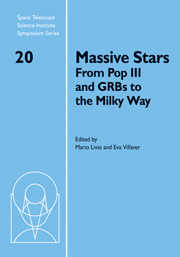Book contents
- Frontmatter
- Contents
- Participants
- Preface
- High-mass star formation by gravitational collapse of massive cores
- Observations of massive-star formation
- Massive-star formation in the Galactic center
- An x-ray tour of massive-star-forming regions with Chandra
- Massive stars: Feedback effects in the local universe
- The initial mass function in clusters
- Massive stars and star clusters in the Antennae galaxies
- On the binarity of Eta Carinae
- Parameters and winds of hot massive stars
- Unraveling the Galaxy to find the first stars
- Optically observable zero-age main-sequence O stars
- Metallicity-dependent Wolf-Rayet winds
- Eruptive mass loss in very massive stars and Population III stars
- From progenitor to afterlife
- Pair-production supernovae: Theory and observation
- Cosmic infrared background and Population III: An overview
Pair-production supernovae: Theory and observation
Published online by Cambridge University Press: 04 August 2010
- Frontmatter
- Contents
- Participants
- Preface
- High-mass star formation by gravitational collapse of massive cores
- Observations of massive-star formation
- Massive-star formation in the Galactic center
- An x-ray tour of massive-star-forming regions with Chandra
- Massive stars: Feedback effects in the local universe
- The initial mass function in clusters
- Massive stars and star clusters in the Antennae galaxies
- On the binarity of Eta Carinae
- Parameters and winds of hot massive stars
- Unraveling the Galaxy to find the first stars
- Optically observable zero-age main-sequence O stars
- Metallicity-dependent Wolf-Rayet winds
- Eruptive mass loss in very massive stars and Population III stars
- From progenitor to afterlife
- Pair-production supernovae: Theory and observation
- Cosmic infrared background and Population III: An overview
Summary
Nonrotating stars that end their lives with masses 140 M⊙ ≤ M* ≤ 260 M⊙ should explode as pair-production supernovae (PPSNe). Here I review the physical properties of these objects, as well as the prospects for them to be observationally constrained.
In very massive stars, much of the pressure support comes from the radiation field, meaning that they are loosely bound, and that (d lgp/d lg Ρ)adiabatic near the center is close to the minimum value necessary for stability. Near the end of C/O burning, the central temperature increases to the point that photons begin to be converted into electron–positron pairs, softening the equation of state below this critical value. The result is a runaway collapse, followed by explosive burning that completely obliterates the loosely bound star. While these explosions can be up to 100 times more energetic than core collapse and Type Ia supernovae, their peak luminosities are only slightly greater. However, due both to copious Ni56 production and hydrogen recombination, they are brighter much longer, and remain observable for ≈1 year.
Since metal enrichment is a local process, PPSNe should occur in pockets of metal-free gas over a broad range of redshifts, greatly enhancing their detectability, and distributing their nucleosynthetic products about the Milky Way. This means that measurements of the abundances of metal-free stars should be thought of as directly constraining these objects.
- Type
- Chapter
- Information
- Massive StarsFrom Pop III and GRBs to the Milky Way, pp. 209 - 227Publisher: Cambridge University PressPrint publication year: 2009



